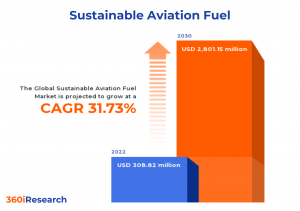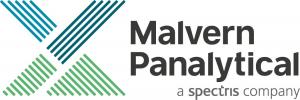
The Global Sustainable Aviation Fuel Market to grow from USD 308.82 million in 2022 to USD 2,801.15 million by 2030, at a CAGR of 31.73%.
PUNE, MAHARASHTRA, INDIA , November 17, 2023 /EINPresswire.com/ — The “Sustainable Aviation Fuel Market by Fuel Type (Biofuel, Hydrogen Fuel, Power to Liquid Fuel), Blending Efficiency (30% to 50%, Above 50%, Below 30%), Manufacturing Technology, End-Use – Global Forecast 2023-2030″ report has been added to 360iResearch.com’s offering.
The Global Sustainable Aviation Fuel Market to grow from USD 308.82 million in 2022 to USD 2,801.15 million by 2030, at a CAGR of 31.73%.
Request a Free Sample Report @ https://www.360iresearch.com/library/intelligence/sustainable-aviation-fuel?utm_source=einpresswire&utm_medium=referral&utm_campaign=sample
Sustainable aviation fuels (SAF) are eco-friendly alternative fuels used in commercial and military aircraft. SAFs are made from renewable resources such as waste oils, agricultural residues, non-food crops, and advanced biofuel technologies, including algae-derived biofuels and synthetic paraffinic kerosene (SPK). The primary end-users include airlines, cargo carriers, governments, and defense organizations with the overarching goal of reducing greenhouse gas emissions associated with conventional jet fuel. Stricter emission standards set by regulatory bodies to adopt green initiatives and the availability of incentives such as tax credits and grants encourage research and development in SAF technology, elevating the usage of sustainable aviation fuels. Increasing air traffic globally and continuous increase in crude oil prices is the growing need for cleaner alternatives across the aviation sector to mitigate environmental impacts. High production costs associated with sustainable aviation fuels hampers market growth. The growing development of novel pathways to convert waste materials into valuable fuels is expected to create opportunities for market growth.
Fuel Type: Growing adoption of biofuels to decarbonize the aviation sector
Biofuels, derived from organic matter such as plants and waste materials, are a sustainable alternative to traditional jet fuels. They emit fewer greenhouse gases (GHGs) compared to fossil fuels and potentially contribute to the decarbonization of the aviation industry. Hydrogen fuel is another promising solution for achieving emissions-free air travel. When used in a fuel cell or burned in an engine-generator set-up, hydrogen produces only water as a byproduct, significantly reducing GHG emissions. Power-to-liquid (PtL) fuels involve synthesizing liquid hydrocarbon fuels such as jet fuel by using renewable electricity to convert water and carbon dioxide into liquid hydrocarbons. The advantage of PtL fuels lies in their compatibility with existing jet engines and fuel infrastructure, making them a feasible solution for reducing aviation’s carbon footprint.
Manufacturing Technology: Increasing usage of Fischer Tropsch Synthetic Paraffinic Kerosene (FT-SPK) that provides cleaner-burning fuel
Alcohol to Jet SPK (ATJ-SPK) technology involves the utilization of various feedstocks, including agricultural residues, municipal solid waste, and dedicated energy crops. Catalytic Hydrothermolysis Jet (CHJ) converts lipids sourced from vegetable oils and waste fats into renewable jet fuel through catalytic hydrothermolysis, followed by hydrotreatment. Fischer Tropsch Synthetic Paraffinic Kerosene (FT-SPK) technology synthesizes fuel by converting carbon-based feedstocks, such as biomass and natural gas, into synthetic gas and then transforming it into liquid hydrocarbons. Hydroprocessed fatty acid esters and fatty acids – Synthetic Paraffinic Kerosene (HEFA-SPK) is a prominent technology used in the production of sustainable aviation fuels (SAF). The process involves converting bio-based feedstocks, primarily derived from waste oils, animal fats, and non-edible plant oils, into advanced biofuels suitable for use in aviation. The key advantage of HEFA-SPK fuels is their ability to reduce greenhouse gas emissions compared to conventional jet fuel while maintaining high performance and compatibility with existing aircraft engines and infrastructure. Synthetic Iso-paraffin from Fermented Hydroprocessed Sugar (HFS-SIP) involves fermenting sugar into farnesene and then converting it into iso-paraffin through hydroprocessing. The resulting fuel has high energy density and excellent cold-flow properties.
End-Use: Emerging potential of SAFs across commercial aviation to reduce environmental impact
The business & general aviation segment encompasses private jet operators, charter flights, and smaller regional airlines. In this sector, the need for sustainable aviation fuel (SAF) is driven by corporate social responsibility goals, environmental regulations, and customer demand for greener travel options. The commercial aviation sector started using SAFs to meet international emission reduction targets set by organizations such as the International Civil Aviation Organization (ICAO). Military aviation includes armed forces worldwide seeking to reduce their carbon footprint and dependency on fossil fuels through the use of SAFs. Unmanned Aerial Vehicles (UAVs) are used across various industries for applications such as aerial photography, surveillance, agriculture, and transportation. The use of SAFs is increasing in UAVs to minimize their environmental impact.
Blending Efficiency: Expanding usage of sustainable aviation fuel with blending efficiency of 30% to 50% owing to its cost-effectiveness
A blending efficiency range of 30% to 50% represents an optimal balance between environmental benefits and cost-effectiveness for many airlines. SAF, with this efficiency level, effectively reduces greenhouse gas emissions while maintaining compatibility with existing aircraft engines and fuel infrastructure. While SAF, with a blending efficiency above 50%, offers substantial reductions in greenhouse gas emissions, however, it requires additional investment in engine modifications and advanced fuel infrastructure. Airlines focusing on rapid decarbonization prefer this category despite potential cost implications. SAF, with a blending efficiency below 30%, is ideal for airlines that are gradually transitioning towards sustainable aviation solutions or facing budget constraints. Although this category offers limited environmental benefits compared to higher-efficiency options, it still represents progress in reducing emissions.
Regional Insights:
The United States has one of the largest air passenger and freight markets globally, and as per the International Trade Administration (ITA), over 58,000 tons of cargo are transported every day. According to the Federal Aviation Administration (FAA), the total commercial aircraft fleet is estimated to reach 8,270 in 2037, owing to a continuous increase in air cargo. The usage of aircraft for cargo transportation, last-mile delivery, medical emergencies, air shuttle, private transport, and other areas has been increasing in Brazil, Canada, the U.S., and Chile due to high congestion and the indirect nature of routes with higher circuity factors for ground-based vehicles, creating a demand for sustainable aviation fuels in Americas. The ongoing adoption of various sustainable aviation fuels by airlines across Asia-Pacific is expected to create a platform for the growth of the market in Asia-Pacific. In December 2021, Indigo Airlines, India, signed an agreement with the Dehradun-based Council of Scientific and Industrial Research-Indian Institute of Petroleum (CSIRIIP) to develop and supply SAF at the global level. In June 2021, Japan Airlines (JAL) finished the test of a mixture of two different types of sustainable aviation fuel produced domestically in Japan. The rising availability of government support in terms of tax credits and grants to expand the manufacturing of SAFs is expected to create a platform for market growth in EMEA.
FPNV Positioning Matrix:
The FPNV Positioning Matrix is essential for assessing the Sustainable Aviation Fuel Market. It provides a comprehensive evaluation of vendors by examining key metrics within Business Strategy and Product Satisfaction, allowing users to make informed decisions based on their specific needs. This advanced analysis then organizes these vendors into four distinct quadrants, which represent varying levels of success: Forefront (F), Pathfinder (P), Niche (N), or Vital(V).
Market Share Analysis:
The Market Share Analysis offers an insightful look at the current state of vendors in the Sustainable Aviation Fuel Market. By comparing vendor contributions to overall revenue, customer base, and other key metrics, we can give companies a greater understanding of their performance and what they are up against when competing for market share. The analysis also sheds light on just how competitive any given sector is about accumulation, fragmentation dominance, and amalgamation traits over the base year period studied.
Key Company Profiles:
The report delves into recent significant developments in the Sustainable Aviation Fuel Market, highlighting leading vendors and their innovative profiles. These include Aemetis, Inc., Amyris Inc, DGFuels, LLC, Eni S.p.A., Fulcrum BioEnergy, Inc., Gevo Inc., Honeywell International Inc., LanzaTech, Inc., Lummus Technology LLC, Neste Oyj, Preem AB, Raven SR, Inc., Red Rock Biofuels, Sasol Limited, Shell PLC, SkyNRG B.V., Swedish Biofuels AB, TotalEnergies SE, World Energy, LLC, and ZeroAvia, Inc..
Inquire Before Buying @ https://www.360iresearch.com/library/intelligence/sustainable-aviation-fuel?utm_source=einpresswire&utm_medium=referral&utm_campaign=inquire
Market Segmentation & Coverage:
This research report categorizes the Sustainable Aviation Fuel Market in order to forecast the revenues and analyze trends in each of following sub-markets:
Based on Fuel Type, market is studied across Biofuel, Hydrogen Fuel, and Power to Liquid Fuel. The Hydrogen Fuel is projected to witness significant market share during forecast period.
Based on Blending Efficiency, market is studied across 30% to 50%, Above 50%, and Below 30%. The 30% to 50% is projected to witness significant market share during forecast period.
Based on Manufacturing Technology, market is studied across Alcohol to Jet SPK (ATJ-SPK), Catalytic Hydrothermolysis Jet (CHJ), Fischer Tropsch Synthetic Paraffinic Kerosene (FT-SPK), Hydroprocessed Fatty Acid Esters and Fatty Acids-Synthetic Paraffinic Kerosene (HEFASPK), and Synthetic Iso-paraffin from Fermented Hydroprocessed Sugar (HFS-SIP). The Synthetic Iso-paraffin from Fermented Hydroprocessed Sugar (HFS-SIP) is projected to witness significant market share during forecast period.
Based on End-Use, market is studied across Business & General Aviation, Commercial Aviation, Military Aviation, and Unmanned Aerial Vehicle. The Military Aviation is projected to witness significant market share during forecast period.
Based on Region, market is studied across Americas, Asia-Pacific, and Europe, Middle East & Africa. The Americas is further studied across Argentina, Brazil, Canada, Mexico, and United States. The United States is further studied across California, Florida, Illinois, New York, Ohio, Pennsylvania, and Texas. The Asia-Pacific is further studied across Australia, China, India, Indonesia, Japan, Malaysia, Philippines, Singapore, South Korea, Taiwan, Thailand, and Vietnam. The Europe, Middle East & Africa is further studied across Denmark, Egypt, Finland, France, Germany, Israel, Italy, Netherlands, Nigeria, Norway, Poland, Qatar, Russia, Saudi Arabia, South Africa, Spain, Sweden, Switzerland, Turkey, United Arab Emirates, and United Kingdom. The Europe, Middle East & Africa commanded largest market share of 38.96% in 2022, followed by Americas.
Key Topics Covered:
1. Preface
2. Research Methodology
3. Executive Summary
4. Market Overview
5. Market Insights
6. Sustainable Aviation Fuel Market, by Fuel Type
7. Sustainable Aviation Fuel Market, by Blending Efficiency
8. Sustainable Aviation Fuel Market, by Manufacturing Technology
9. Sustainable Aviation Fuel Market, by End-Use
10. Americas Sustainable Aviation Fuel Market
11. Asia-Pacific Sustainable Aviation Fuel Market
12. Europe, Middle East & Africa Sustainable Aviation Fuel Market
13. Competitive Landscape
14. Competitive Portfolio
15. Appendix
The report provides insights on the following pointers:
1. Market Penetration: Provides comprehensive information on the market offered by the key players
2. Market Development: Provides in-depth information about lucrative emerging markets and analyzes penetration across mature segments of the markets
3. Market Diversification: Provides detailed information about new product launches, untapped geographies, recent developments, and investments
4. Competitive Assessment & Intelligence: Provides an exhaustive assessment of market shares, strategies, products, certification, regulatory approvals, patent landscape, and manufacturing capabilities of the leading players
5. Product Development & Innovation: Provides intelligent insights on future technologies, R&D activities, and breakthrough product developments
The report answers questions such as:
1. What is the market size and forecast of the Sustainable Aviation Fuel Market?
2. Which are the products/segments/applications/areas to invest in over the forecast period in the Sustainable Aviation Fuel Market?
3. What is the competitive strategic window for opportunities in the Sustainable Aviation Fuel Market?
4. What are the technology trends and regulatory frameworks in the Sustainable Aviation Fuel Market?
5. What is the market share of the leading vendors in the Sustainable Aviation Fuel Market?
6. What modes and strategic moves are considered suitable for entering the Sustainable Aviation Fuel Market?
Mr. Ketan Rohom
360iResearch
+ 1 530-264-8485
[email protected]
![]()
Originally published at https://www.einpresswire.com/article/669143917/sustainable-aviation-fuel-market-worth-2-801-15-million-by-2030-exclusive-report-by-360iresearch



